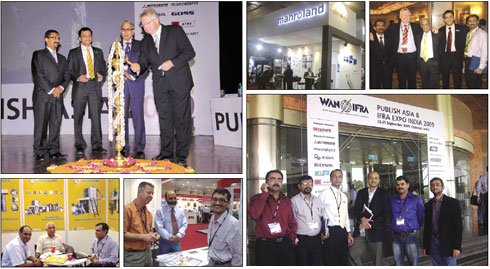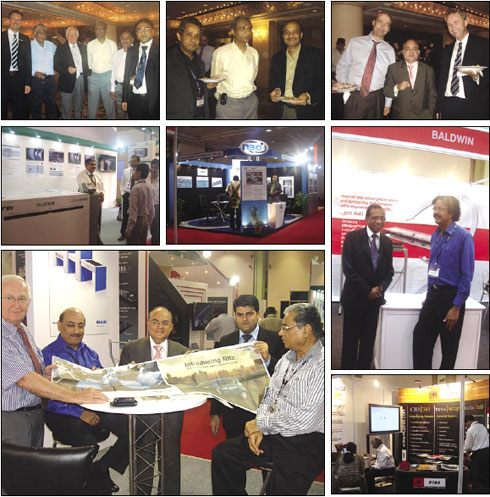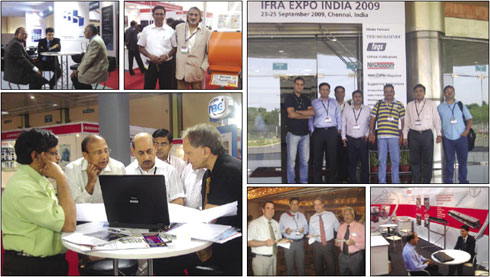|
Main Stories
IFRA Expo India 09 concludes in
Chennai enthusing the industry –stimulates newspaper publishers' grit to face emerging challenges continuing growth process  Benefiting from feel-good factor resurgence in the Asian economy, IFRA Expo India 09 along with Publish Asia concluded in Chennai, exceeding all expectations attracting over 1550 visitors, with more than fifty exhibiting suppliers presenting their latest products and innovations. Already hailed as the second largest expo in the world for the newspaper publishing industry, the three-day event witnessed almost all the leading players in the industry from India and abroad including, 4Cplus, ABB, Baldwin, Ferag India, Fujifilm, Goss, J Mahabeer, manroland India, Manugraph, Mediawide Labs, Mitsubishi, Muller Martini, NBG, Newstech, ppi Media, Pressline, QuadTech, Quark, Shree Refrigerations, and Wifag.
Benefiting from feel-good factor resurgence in the Asian economy, IFRA Expo India 09 along with Publish Asia concluded in Chennai, exceeding all expectations attracting over 1550 visitors, with more than fifty exhibiting suppliers presenting their latest products and innovations. Already hailed as the second largest expo in the world for the newspaper publishing industry, the three-day event witnessed almost all the leading players in the industry from India and abroad including, 4Cplus, ABB, Baldwin, Ferag India, Fujifilm, Goss, J Mahabeer, manroland India, Manugraph, Mediawide Labs, Mitsubishi, Muller Martini, NBG, Newstech, ppi Media, Pressline, QuadTech, Quark, Shree Refrigerations, and Wifag.
H eld at Chennai Trade and Convention Centre (Sept 23-25), the international exhibition on trends and technologies in printing and publishing, IFRA Expo India 2009 was inaugurated by Reiner Mittelbach, CEO of WAN-IFRA, who called for a change in the mindset of newspaper publishers in dealing with the advertisers. Delivering his keynote address on the topic ‘from newspapers to consumer centric communication’ Reiner emphasised that newspapers should provide additional values to the advertisers through a number of ways, instead of just trying to sell their advertising space. Thomas Jacob, deputy CEO of WAN-IFRA, presented a brief background to the two special reports released on the occasion. The Asian edition of World Press Trends from WAN-IFRA, a compilation of statistics, will help the publishers understand the trends, the penetration and the growth opportunities in the media world. The first copy of this report was released by Pichai Chuensuksawadi, chairman of Asia Pacific Committee and received by K N Shanth Kumar, member of the Board and Executive Committee of WAN-IFRA. The second special report on ‘New Printing Plants’ will prove as an invaluable tool to those who are planning, designing and constructing a new printing plant, helping in avoiding costly mistakes. This report was released by Manfred Werfel, deputy CEO of WAN-IFRA and received by K Balaji, chairman of WAN-IFRA South Asia Committee. N Murali, director of IFRA India and MD of The Hindu, welcomed the gathering and mentioned that inspite of the downturn in the economy, the response to the IFRA Expo India 09 has been far better than expected both in terms of exhibitors’ participation and the number of registered delegates (620) for Publish Asia Conference 2009. The Publish Asia Conference 09 featured four concurrent conferences each relevant to CEOs, circulation executives, chief technical officers (CTOs) and production executives in the newspaper world. Introduced for the first time at Publish Asia, ‘CTO Conference’ and ‘Circulation Conference’ highlighted the importance of integrating systems management with strategies in newspaper companies and the importance of circulation management for increasing yield and monetising the reach of newspapers, respectively. In CTO Conference, Rajesh Rajan, general manager-IT strategy & development of Anandabazar Patrika gave presentation on changing role of chief technical officers (CTOs) in publishing houses: the challenges and the way forward. According to him, the role of CTO in any industry verticals is to: provide a technology vision and leadership to create a transformational change in the business landscape; formulate the technology strategic roadmap of the enterprise aligned to the business roadmap; own strategic technology implementations; monitor emerging technology trends, evaluate and advocate it’s use even before business recognizes it; part if senior management involved in business strategy, prioritizing and budgeting tech strategy, sales person to sell tech initiatives across the organisation and the stakeholders; and promote innovation, being a business driver not just a enabler. Key strategies for the way forward should include: unified content management for cross media convergence; integrated ads and classified for cross selling or 360 degree selling; multimedia consumer engagement; business intelligence and mobile intelligence; outsourced IT infrastructure and maintenance; movement to the cloud (SAAS); agile business through SOA; online classifieds boom – migrating from print; leverage outsourced infrastructure to micro splits for multiple editions; and 3G and it’s online penetration.  Talking about optimising the workflow from publishing to production, R Ramasubramanian, general manager-electronics of The Hindu; pointed out challenges in: ad workflow, photo workflow, text workflow, graphics workflow, page planning/production, and typeset/plate production. Making presentation on handling video and high volume data in newspaper websites, Renjit Paul, deputy manager-production of Malayala Manorama mentioned that the biggest challenges for any website administrator are unexpected traffic and scalability concerns. Owing to increasing importance of rich media, websites incorporate more and more rich media components, especially videos. Studies show that people retain only ten percent of the information they read, twenty percent of the info they hear, but fifty percent of the info they see and hear. Speaking on setting up the right IT workflow, Tridib Bordoloi, head-engineering, Press Trust of India stated, “To overcome IT problems, we need to define the scope of IT department; understand what hardware and software are needed to make sure deadlines are not slipped; plan storage, backup and disaster recovery apart from planning network and connectivity. He called for to take one step at a time, networks & servers, computers, desktop software, enterprise software, and enterprise security. N Ravindran, general manager, E&C, New Indian Express, presented case study focusing on planning a new publishing system. David Bicknell, CTO of Hindustan Times was also included among the speakers. In the Circulation conference, Ashish Aron, vice president, 4Cplus presented an assessment for evolution stages of the publication’s circulation management. According to him, distribution policy insists on: manual system or a stand alone software (subscribers neglected) in the first stage; the distributor information is captured, supply monitored manually, strategy based on ‘gut feel’, label system generated, and may be handling institutional sales, during the second stage; circulation, subscribers, surveys (PCC), online labeling, demand forecasting, logistics planning, and centralized accounts, in the third stage; and real time information, logistics management, multimedia CRM, business analytics, track competition, and customer retention during the fourth stage. So, focus remains on: circulation; circulation and agents; subscription drives, logistics; and readers; during first, second, third, and fourth stages respectively. Speaking on ‘dynamics of single copy sale: does it work in predominately subscription markets?’, Dr Arvind Kalia (national head marketing, Rajasthan Patrika Group) called for making attempt to develop a contingent model for circulation. Presenting important tactics for single copy sales, he pointed out, “We should start with very basic traditional tactics focusing on single copy buyer junctions such as bus stands/railway stations, traffic signals, public utility places –taxi stands, mandis, etc; and single copy reader junctions like tea stalls/Dhabas, public parks, etc.  While other presentations were given by Alok Sanwal (head–iNext, Jagran group) on successful strategies to reach young readers; Bharat Kapadia, member, board of directors, Lokmat Group; Cyril Pereira (vice president-manufacturing, Anandabazar Patrika) on outsourcing circulation; Edward Baral (group marketing manager, Financial Review Group, Fairfax Media) on newspaper circulation business model, and charging for online; Nick Klotz (manager – South Asia, Atex) on Atex circulation solution; and Raul S Buan (president, Best Option Management Consultant) on inefficiency of the daily newspaper circulation system. Magdoom Mohamed, MD, IFRA India proposed the vote of thanks.
nnn
|